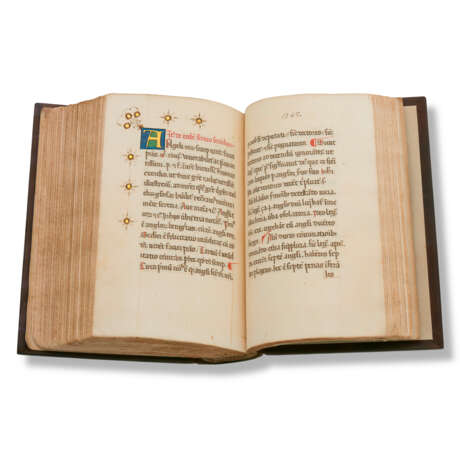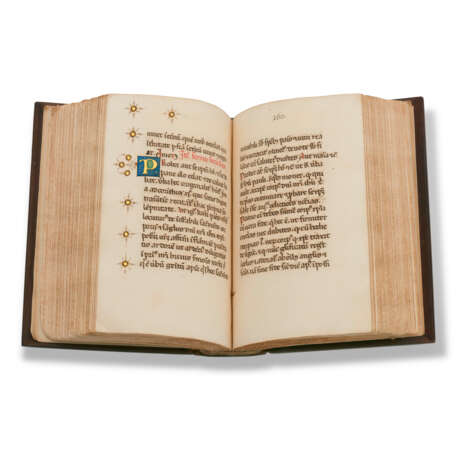ID 870836
Lot 41 | Anonymous northern Italian illuminator
Valeur estimée
£ 15 000 – 20 000
Carthusian Sermons, in Latin, illuminated manuscript on paper [Florence, or northeastern Italy, c.1460-80]
A handsome illuminated manuscript with a finely executed white-vine frontispiece, containing an unpublished collection of Sermons for Carthusian use (with three dedicated to Hugh of Lincoln)
192 x 132mm. ii + 289 +ii leaves, collation: 18, 2-810, 9-1012, 11-2510, 269 (of 10, lacking iii), 2710, 289(of 10, lacking i), 299(of 10, lacking ii), modern foliation 1-291, repeating 263, followed here, 15 lines, ruled space: 110 x 80mm., catchwords survive, rubrics and paraphs in red throughout, small initials touched in red, 41 illuminated initials on purple, green or blue grounds with white and gold tracery and sprays of gold bezants in the margins, 1 large white-vine initial with a three-sided white-vine border incorporating roundels with a deer, a dog, and a monogram 'AR' (lacking three leaves: ff.255, 272, 283; f.250 sliced down to a strip, wormtrack ff.88-106 repaired, occasional small wormholes and slight marginal staining, else in good condition with clean wide margins). Modern brown calf gilt. Fitted quarter-morocco box.
Provenance:
(1) The text suggests Carthusian use, and the decoration of the first page suggests a Florentine origin, so perhaps made for the Certosa del Galluzzo, a short distance outside Florence. A monogram of the letters C.A.R. with a cross in the left border of f.1 is perhaps a reference to the Carthusian order.
(2) 19th?-century ink stamp with remnants of a ?palm on f.1v.
(3) Maggs Bros, cat. 669 (1938), p.2, no 11. There attributed to St Augustine.
(4) Agustin Roberto Edwards Budge, IV (1899-1956): his 1942 bookplate.
Content:
Sermons, for Carthusian use, ff.1-291v: 'Incipiunt Sermones de omnibus festivitabus [sic] in quibus de debito fit sermo in capitulo . f. c. De Nativitate Domini sermo primus', beginning with the first Sermon on the Nativity, 'Omnes qui audierunt [...] Benedicti patres et fratres dilectissimi, ex defecta fragilitatis [...]' (f.1); the second Sermon (f.7); the third Sermon (f.11v); the fourth Sermon (f.16); Sermon on the Feast of St Stephen, beginning 'Dum esset Stephanus plenus spiritu sancto [...] Si omnis corporis mei [...]' (f.19); Sermon on St John the Evangelist, beginning 'In nidulo meo moriar [...]' (f.26); Sermon on the Feast of the Holy Innocents (f.33); first Sermon on the Epiphany (f.46); the second Sermon (f.53v); first Sermon on the Purification of the Virgin Mary (f.61); the second Sermon (f.68); first Sermon on the Annunciation (f.79v); the second Sermon (f.87v); first Sermon on the Resurrection (f.95); the second Sermon (f.105); first Sermon on the Ascension of Christ (f.111); the second Sermon (f.118); the third Sermon (f.120v); first Sermon on Pentecost (f.123v); the second Sermon (f.132v); the third Sermon (f.137); first Sermon on the Holy Trinity (f.140); the second Sermon (f.145); Sermon on the Feast of Corpus Christi (f.149v); the second Sermon (f.159v); first Sermon on the Feast of John the Baptist (f.163v); the second Sermon (f.169v); first Sermon on the Feasts of the Apostles Peter and Paul (f.176); the second Sermon (f.182v); Sermon on the Feast of St Mary Magdalene (f.187); the second Sermon (f.194v); first Sermon on the Assumption of the Virgin (f.201); first Sermon on the Nativity of the Virgin (f.214); Sermon on the Nativity and Sanctification of the Virgin (f.220); Sermon on the Exaltation of the Cross (f.224); Sermon on the Feast of St Michael Archangel (f.238); the second Sermon (f.244v); [f.250, with the opening of another Sermon is cropped to a slim strip]; first Sermon on the Feast of Blessed Hugh of Lincoln, beginning 'Quasi stella matutina [...] Reverendi patres et fratres in Christo dilectissimi. Festum beatissum Hugonis Lynconiensis episcopi ordinis Cartusienis celebrandum nobis advenit' (f.262v); the second Sermon, beginning 'Letare Zabulon in exitu tuo [...] Carissimi in Christo patres et fratres [...] atque pertineat ad laudem beatissimi Hugonis Lynconiensis episcopi ordinis Cart. cuius hodie festum [...]' (f.268); the third Sermon (f.278).
The Sermons in the present manuscript do not appear in Schneyer, Repertorium der lateinischen Sermones des Mittelalters für die Zeit von 1150–1350, 1969-1990 and are apparently unpublished. The three sermons dedicated to Hugh of Lincoln, though, clearly indicate a Carthusian orientation. Hugh, bishop of Lincoln (c.1135-1140 - 1200), canonised by Pope Honorius III in 1220, is an unusual focus for a series of Sermons, and his cult would certainly not have been widespread enough to have him included in a Sermon book for any order other than the Carthusians.
The elegant and carefully-rendered white-vine decoration is typical of Italian humanist manuscripts of the second half of the 15th century. The seated deer in the roundel and the collared dog are features of the Florentine work of artists like Francesco de Antonio del Chierico (for example in a Pliny in Florence, Biblioteca Medicea Laurenziana, pl.66.9, f.6), and the white-vine borders also suggest an origin in or near Florence, but the illuminated initials throughout the manuscript, with their marginal sprays of burnished gold bezants, have a north-eastern Italian flavour.
Special notice
No VAT on hammer price or buyer's premium.
| Adresse de l'enchère |
CHRISTIE'S 8 King Street, St. James's SW1Y 6QT London Royaume-Uni | |
|---|---|---|
| Aperçu |
| |
| Téléphone | +44 (0)20 7839 9060 | |
| Commission | see on Website | |
| Conditions d'utilisation | Conditions d'utilisation |






